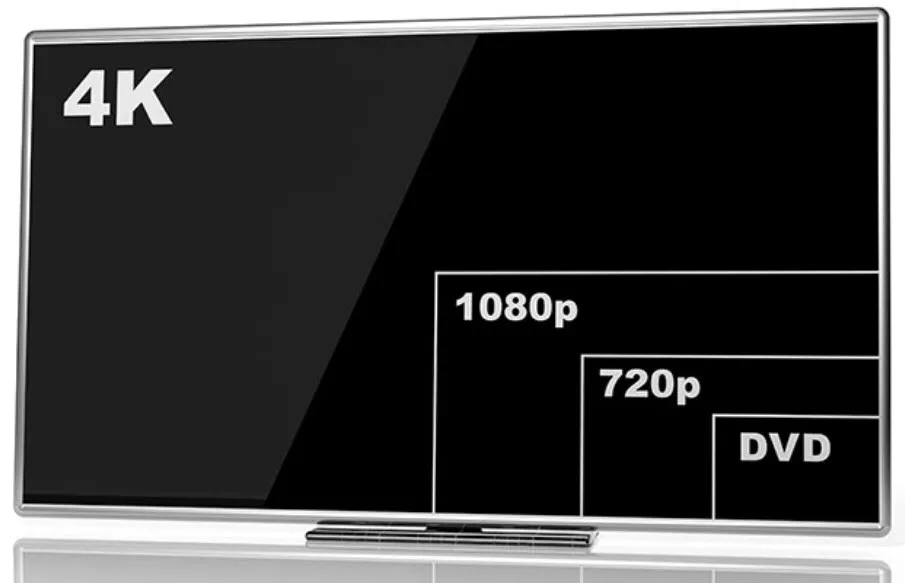720p Format
720p is the short form for one of the two high-definition (HDTV) formats (7) (the other is 1080i/1080p (8)) “720” stands for the number of lines, i.e. vertical pixels. The horizontal resolution is 1280 pixels (9). Technically correct, the 720p format is described as 1280×720 (10). 720p is progressive (6), i.e. 720 lines are always displayed on a full screen (5). 720p is always progressive, unlike 1080p (4), where there is an interlaced variant with 1080i (1) and a progressive variant with 1080p (3).
Devices for 720p no longer play a role in the consumer electronics market above the entry-level classes; the market share of 1080p devices is well over 90%. As a result, hardly any screens are produced for the 720p format (1280×720 pixels).
For superior definitions, please see also 1080p comparisons, and the analysis of 1440p and 4k updated.

The abbreviation 720p stands for the display of videos with 1280 x 720 pixels in full-screen mode, i.e. all pixels are set to a new image at the same time (progressive). This resolution is significantly higher than PAL but is still far from 1080i or 1080p.
720p is the abbreviation for a certain picture quality, also known as HD Ready. The 720 stands for the number of pixels in the vertical plane. The total resolution at 720p is 1280×720 pixels, which is just under one megapixel. That’s about twice as many as in the previously widespread PAL format, but only half as many as in Full HD TVs with 1080p. Televisions with a resolution of 720p usually have an aspect ratio of 16:9 and are therefore suitable for displaying modern widescreen formats.
720p signals are transmitted with a resolution of 1280×720 pixels and result in a video signal of 720 lines. 720p signals are transmitted in a 16:9 aspect ratio. In terms of still images, 720p has a resolution of 921,600 pixels, slightly more than twice as high as the PAL format with 414,720 pixels, but less than half the resolution of the world’s leading 1080 standards, which cover 2,073,600 pixels.
The Full-HD format has 1920×1080 pixels, devices for it are mainly sold with a 1080p display.
A 720p image displayed with such devices must, therefore, be upscaled by a factor of 2:3, which in principle generates scaling artifacts, just like when scaling PAL and SD signals. Lower-resolution HD-ready screens usually display 1366×768 pixels. Here, to make full use of the screen, scaling and interpolation must be performed with non-integer ratios, which leads to visible errors. However, these resolutions all have an aspect ratio of 16:9, which allows a full-screen display to be created without distortion.
Progressive image transmission at 720p
While the 720 indicates the number of vertical image pixels, the p stands for the so-called progressive image transfer. This transmission technique, also known as full-screen transmission, only transmits entire pictures. In contrast to interlaced transmission, in which two fields are transmitted, progressive transmissions appear smoother. Viewers do not notice any line flicker. However, the transmission of full frames is linked to the presence of suitable interfaces on receivers and TV sets.
Particularly at a great distance from the television set, the difference to higher resolutions is hardly visible to the naked eye. Private broadcasters mainly use the 1080i format. This format is also recommended and used by most film studios and consumer electronics manufacturers.
What is HD Ready?
720p was the first step on the road to high definition television. The higher resolution of modern televisions allows for a sharper picture with more details by displaying different pixels. Television pictures become more realistic and the viewers feel increasingly immersed in the action. However, the 720p resolution was only the first step in the development of HD television.
In the meantime, higher resolutions have become widely accepted, allowing even sharper television pictures. Decisive for whether a Full HD TV is worthwhile compared to a device with 720p resolution is not only the distance to the screen but also its size. Up to a size of 36 inches, the difference is hardly noticeable to the naked eye in a normal living room. Streaming with 720p is also well suited for slow internet connections, as fewer data has to be transferred due to the lower number of pixels.
European Public Broadcasters And 720p Format
Whereas public broadcasters are using 720p formats, private broadcasters in the European Union are moving into 1080i formats, with the notable exception of El Toro TV: a private broadcaster based in Madrid that is using 720p format.
The European Broadcasting Union recommends the 720p format with 50 Hz as the currently optimal solution for HDTV. All major US film studios, consumer electronics, and game console manufacturers, set-top TV providers such as Google, video on demand providers and camera manufacturers use or offer 1080p, 1080psf, 1080i, and upwards as a minimum.
In Europe, the introduction of this HDTV standard was pushed forward by the EBU (European Broadcasting Union). Due to the frame rate of 50 Hz, the official nomenclature is 720p/50 or 720p50. On Blu-ray Discs, however, videos are usually recorded at 1080p and a frame rate of 24 Hz (Cinema mode) to guarantee the best possible playback.
Most public broadcasters in Europe that broadcast in HD quality rely on 720p. These include Arte HD, Das Erste HD, ZDF HD, and the HD channels of ORF and SRF. They are thus following the recommendation of the European Broadcasting Union, which considers this to be the currently optimal technology for HD television.
Further Readings
We have some other interesting articles for you to read, we have selected our top articles below, and tried to keep this list short.
We have a technical vademecum where we discuss industry terminology and how it can be useful for you. Selected examples are the definition of PCM audio, then comes the comparison between PCM and Bitstream, the comparison between DTS Neo 2.5 and Dolby Digital, and the process to match amplifiers to speakers.
Also, we have reviewed some interesting DAC: The Elgar Plus from dCS, and the Schiit stack. where the Modi 3 behaves as an entry-level DAC.
In our reviews of AV receivers, we can recommend you to read some of our favorites, the ones that we liked the most, and trying to make the list short, we have the Denon AVR-X2500H, the Onkyo TX-NR686. We also have reviewed completely the Denon 8K receivers where we have studied the 8K Denon AVR-X2700H, the Denon AVC-X6700H, the AVC-X4700H, and the AVC-X3700H.
If you are into amplifiers, my favorite is the McIntosh MA9000, and that is why I would like to recommend you to read that review. My second favorite amplifier is the Mark Levinson 5805.
Regarding speakers, we have reviewed tiny bookshelf-speaker devices to large towers. My favorites were: the Devialet Gold, the Devialet Silver, the ProAc Response DT8, the Bowers and Wilkins 805 D3,
We do not review many headphones, but if you want a Sennheiser headphone for less than 100 dollars, we have this Sennheiser HD595 review.
We have some TV and monitor reviews and here we recommend the Samsung NU8000 (for gamers!) and my favorite is the review of the classical Pioneer Kuro.
Our home theater aficionados want to know everything about video definitions and configurations. So we studied 720p, how to scale it to 1080p the right way, and compared 1080p with 1440p and demonstrated why 1440p is not always better. Likewise, we had the urge to compare 1440k with 4K and try to find out how much are we gaining with the change.

I am Bob. I work as an audio engineer and audio technician. I work in mastering and arranging bridges in existing songs and the arrangement and orchestration of the chorus. In Planet HiFi I test gear for a couple of days and write a review. I also write about AV topics, amplifiers, speakers, and headphones.

